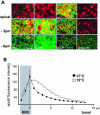Lipid-dependent bidirectional traffic of apolipoprotein B in polarized enterocytes
- PMID: 14565984
- PMCID: PMC307534
- DOI: 10.1091/mbc.e03-04-0215
Lipid-dependent bidirectional traffic of apolipoprotein B in polarized enterocytes
Abstract
Enterocytes are highly polarized cells that transfer nutrients across the intestinal epithelium from the apical to the basolateral pole. Apolipoprotein B (apoB) is a secretory protein that plays a key role in the transepithelial transport of dietary fatty acids as triacylglycerol. The evaluation of the control of apoB traffic by lipids is therefore of particular interest. To get a dynamic insight into this process, we used the enterocytic Caco-2 cells cultured on microporous filters, a system in which the apical and basal compartments can be delimited. Combining biochemical and morphological approaches, our results showed that, besides their role in protection from degradation, lipids control the intracellular traffic of apoB in enterocytes. A supply of fatty acids and cholesterol is sufficient for the export of apoB from the endoplasmic reticulum and its post-Golgi traffic up to the apical brush-border domain, where it remains until an apical supply of complex lipid micelles signals its chase down to the basolateral secretory domain. This downward traffic of apoB involves a microtubule-dependent process. Our results demonstrate an enterocyte-specific bidirectional process for the lipid-dependent traffic of a secretory protein.
Figures








Similar articles
-
Regulation of triacylglycerol and phospholipid trafficking by fatty acids in newborn swine enterocytes.Am J Physiol Gastrointest Liver Physiol. 2002 May;282(5):G817-24. doi: 10.1152/ajpgi.00397.2001. Am J Physiol Gastrointest Liver Physiol. 2002. PMID: 11960778
-
Sensing of dietary lipids by enterocytes: a new role for SR-BI/CLA-1.PLoS One. 2009;4(1):e4278. doi: 10.1371/journal.pone.0004278. Epub 2009 Jan 26. PLoS One. 2009. PMID: 19169357 Free PMC article.
-
Studies of the sites of intracellular degradation of apolipoprotein B in Hep G2 cells.J Biol Chem. 1992 Nov 5;267(31):22630-8. J Biol Chem. 1992. PMID: 1429611
-
Formation and transport of chylomicrons by enterocytes to the lymphatics.Am J Physiol. 1986 Jun;250(6 Pt 1):G715-26. doi: 10.1152/ajpgi.1986.250.6.G715. Am J Physiol. 1986. PMID: 3521320 Review.
-
Use of immunoelectron microscopy and intestinal models to explore the elaboration of apolipoproteins required for intraenterocyte lipid transport.Microsc Res Tech. 2000 May 15;49(4):374-82. doi: 10.1002/(SICI)1097-0029(20000515)49:4<374::AID-JEMT6>3.0.CO;2-W. Microsc Res Tech. 2000. PMID: 10820521 Review.
Cited by
-
Characterization of a spontaneously polarizing HT-29 cell line, HT-29/cl.f8.In Vitro Cell Dev Biol Anim. 2004 Nov-Dec;40(10):297-302. doi: 10.1290/04100061.1. In Vitro Cell Dev Biol Anim. 2004. PMID: 15780006
-
Oxidized LDL Downregulates ABCA1 Expression via MEK/ERK/LXR Pathway in INS-1 Cells.Nutrients. 2021 Aug 29;13(9):3017. doi: 10.3390/nu13093017. Nutrients. 2021. PMID: 34578896 Free PMC article.
-
Gut triglyceride production.Biochim Biophys Acta. 2012 May;1821(5):727-35. doi: 10.1016/j.bbalip.2011.09.013. Epub 2011 Oct 2. Biochim Biophys Acta. 2012. PMID: 21989069 Free PMC article.
-
Bovine prion is endocytosed by human enterocytes via the 37 kDa/67 kDa laminin receptor.Am J Pathol. 2005 Oct;167(4):1033-42. doi: 10.1016/S0002-9440(10)61192-3. Am J Pathol. 2005. PMID: 16192638 Free PMC article.
-
Phosphate Improves Mitochondrial Function and Reduces Pancreatitis in Hypertriglyceridemia.FASEB J. 2025 Aug 31;39(16):e70983. doi: 10.1096/fj.202501155R. FASEB J. 2025. PMID: 40857028 Free PMC article.
References
-
- Abumrad, N., Coburn, C., and Ibrahimi, A. (1999). Membrane proteins implicated in long-chain fatty acid uptake by mammalian cells: CD36, FATP and FABPm. Biochim. Biophys. Acta 1441, 4–13. - PubMed
-
- Boren, J., Rustaeus, S., and Olofsson, S.O. (1994). Studies on the assembly of apolipoprotein B-100- and B-48-containing very low density lipoproteins in McA-RH7777 cells. J. Biol. Chem. 269, 25879–25888. - PubMed
-
- Bostrom, K., Boren, J., Wettesten, M., Sjoberg, A., Bondjers, G., Wiklund, O., Carlsson, P., and Olofsson, S.O. (1988). Studies on the assembly of apo B-100-containing lipoproteins in HepG2 cells. J. Biol. Chem. 263, 4434–4442. - PubMed
-
- Carpentier, A., Taghibiglou, C., Leung, N., Szeto, L., Van Iderstine, S.C., Uffelman, K.D., Buckingham, R., Adeli, K., and Lewis, G.F. (2002). Ameliorated hepatic insulin resistance is associated with normalization of microsomal triglyceride transfer protein expression and reduction in very low density lipoprotein assembly and secretion in the fructose-fed hamster. J. Biol. Chem. 277, 28795–28802. - PubMed
Publication types
MeSH terms
Substances
LinkOut - more resources
Full Text Sources
Medical
Miscellaneous

